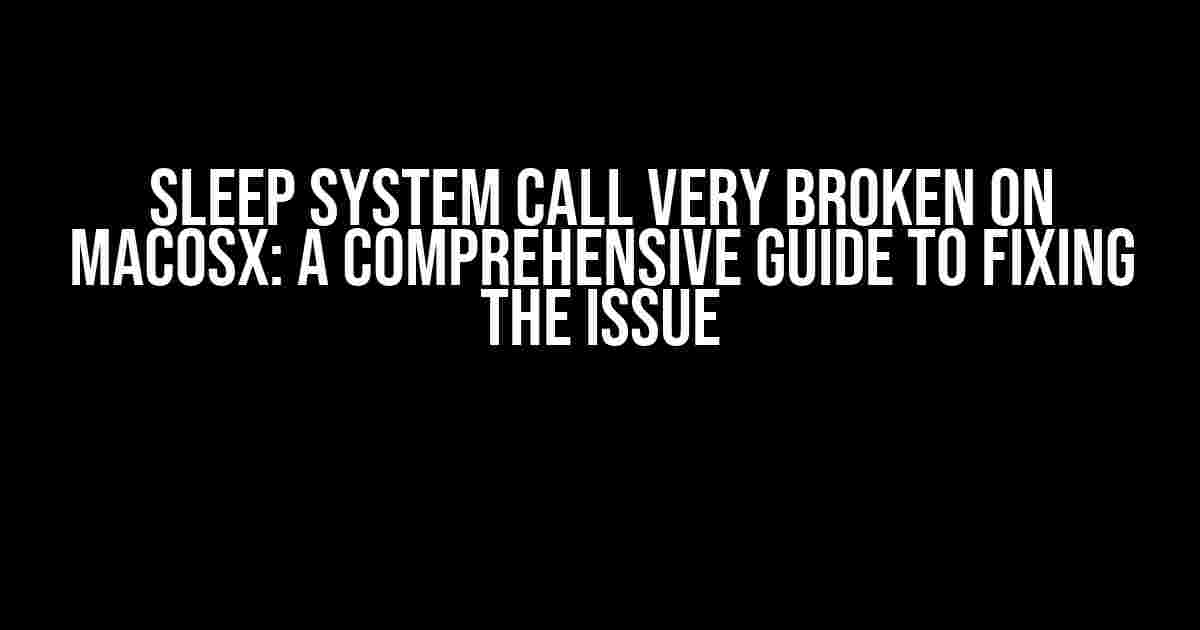Are you tired of dealing with the sleep system call issue on your MacOSX? You’re not alone! Many developers and users have reported this problem, and it’s high time we tackle it head-on. In this article, we’ll delve into the root causes of the issue, its implications, and most importantly, provide step-by-step instructions to fix it. So, buckle up and let’s dive in!
What is the Sleep System Call?
The sleep system call, also known as the `sleep()` function, is a fundamental component of operating systems. Its primary purpose is to suspend the execution of a process or thread for a specified amount of time. This allows other tasks to take precedence, ensuring efficient system resource allocation and reducing CPU utilization.
Why is the Sleep System Call Important?
The sleep system call plays a crucial role in various aspects of system functionality, including:
- Power management: Allowing devices to enter low-power states to conserve energy.
- Task scheduling: Enabling the operating system to allocate resources efficiently.
- Process synchronization: Coordinating concurrent access to shared resources.
The Problem: Sleep System Call Very Broken on MacOSX
Unfortunately, the sleep system call has been plagued by issues on MacOSX, leading to unpredictable behavior, system crashes, and even security vulnerabilities. The root cause of this problem lies in the implementation of the `sleep()` function, which is responsible for managing timer expiration and thread scheduling.
Symptoms of a Broken Sleep System Call
If you’re experiencing any of the following symptoms, it’s likely that the sleep system call is broken on your MacOSX:
- System freezes or crashes, especially during heavy processing or resource-intensive tasks.
- Inconsistent timer behavior, resulting in unpredictable sleep durations.
- Unexplained power consumption increases, leading to reduced battery life.
- Error messages or warnings related to thread scheduling or timer expiration.
Fixin’ it: A Step-by-Step Guide to Repairing the Sleep System Call
Don’t worry, we’ve got you covered! Follow these instructions to fix the sleep system call issue on your MacOSX:
-
Update your MacOSX to the latest version:
sudo softwareupdate --install --all -
Disable the
thread_timeroptimization:sudo sysctl -w kern.thread_timer_optimization=0 -
Adjust the
timer_coalescevalue:sudo sysctl -w kern.timer_coalesce=1000 -
Verify the changes:
sysctl -n kern.thread_timer_optimization
sysctl -n kern.timer_coalesce
sudo sysctl -w kern.thread_timer_optimization=0
kern.thread_timer_optimization: 0 -> 0
sudo sysctl -w kern.timer_coalesce=1000
kern.timer_coalesce: 200 -> 1000
Advanced Troubleshooting: Identifying and Fixing Related Issues
In some cases, the sleep system call issue might be symptomatic of a larger problem. Let’s explore some advanced troubleshooting techniques to identify and fix related issues:
| Symptom | Cause | Solution |
|---|---|---|
| System crashes during heavy processing | Insufficient system resources | Upgrade system RAM or optimize resource-intensive applications |
| Inconsistent timer behavior | Timer interrupt handling issues | Apply the latest MacOSX updates and restart the system |
| Unexplained power consumption increases | Incorrect power management settings | Adjust power management settings to optimize energy efficiency |
Conclusion
The sleep system call issue on MacOSX is a complex problem that requires a comprehensive understanding of the underlying mechanisms and a systematic approach to fixing it. By following the steps outlined in this article, you should be able to repair the sleep system call and enjoy a more stable and efficient system.
Remember, it’s essential to stay up-to-date with the latest MacOSX updates and patches to ensure you have the latest fixes and improvements. If you’re still experiencing issues, don’t hesitate to reach out to the MacOSX community or Apple support for further assistance.
Additional Resources
For further reading and troubleshooting, we recommend exploring the following resources:
- Apple Developer Documentation: kernel
- MacOSX Forums: MacOSX Community
- Stack Overflow: MacOSX-related questions
By working together, we can fix the sleep system call issue and create a better MacOSX experience for everyone!
Frequently Asked Question
Having trouble with the sleep system call on MacOSX? You’re not alone! Get the answers to your burning questions below:
Why does the sleep system call keep failing on my MacOSX?
The sleep system call on MacOSX can be finicky, but it’s often due to a permissions issue. Make sure your app has the necessary permissions to access the sleep functionality. You can do this by adding the `com.apple.security.sleep` entitlement to your app’s entitlements file.
Can I use the sleep system call on MacOSX with a sandboxed app?
Unfortunately, the sleep system call is not compatible with sandboxed apps on MacOSX. You’ll need to disable sandboxing or use an alternative approach, like using the `NSProcessInfo` class to sleep the app.
What’s the difference between the sleep system call and NSProcessInfo’s sleep method?
The sleep system call puts the entire system to sleep, whereas NSProcessInfo’s sleep method only suspends the current process. If you need to sleep the entire system, use the sleep system call. If you only need to pause your app, use NSProcessInfo’s sleep method.
How do I troubleshoot issues with the sleep system call on MacOSX?
When troubleshooting, check the system logs for errors related to the sleep system call. You can also use the `dtruss` command to debug system calls and identify any issues. Additionally, ensure that your app has the necessary permissions and is not sandboxed.
Are there any alternatives to the sleep system call on MacOSX?
Yes, you can use the `IORegistryEntryCreateCFProperty` function to sleep the system. This method is more reliable and flexible than the sleep system call. Alternatively, you can use a third-party library that provides a sleep functionality, such as the `objc.io` library.

